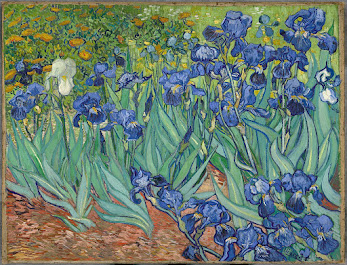Irises - Van Gogh
Irises was just one painting out of Vincent Van Gogh’s scintillating collection of masterpieces. In 1889, Van Gogh was struggling with episodes of self-mutilation and hospitalisation. He decided to submit himself into a mental asylum, where he worked on a total of 130 paintings before his death a year later. One of the paintings he worked on was ‘Irises’, which he painted using inspiration from the gardens in the asylum.
The painting displays a field of flowers, their main colors being: ocean blue, orange-yellow and pearl white. These colors beautifully complement each other and create a sense of harmony. The main subject of the painting are the blue irises which elegantly dance in the wind. In the left-hand corner of the painting, Van Gogh paints the brown soil beneath the flowers, which gradually disappears as the green leaves and irises begin to conceal its presence. Van Gogh uses a lot of green in this painting, which makes the azure blue of the lilacs stand out more. In the midst of the blue lilacs, there is one conspicious white flower standing oddly on the left side of the page. It looks intriguing but is drowned out by the royal blue of the majestic flowers.
Van Gogh uses a range of different brush techniques in this artwork. He uses smooth strokes when painting the leaves and the stems, which creates a sense of tranquility and grace. He uses multiple shades and tones of green when painting the leaves. You can clearly notice the leaves closer to the painting have a more lighter blue-green whereas in the background, the green is much more prominent and bold. The soil seems to have much more texture and there is a range of different shades of brown. The effect he uses for the soil makes it look rough and disorderly. Some parts of the soil seem fresh, some old. He uses quick brush strokes and under closer inspection, looks rather peculiar.
The sapphire blue of the irises is what makes the artwork truly resplendent. The richness of the multiple tints of blue blurs out all the extra colors and creates an surreal effect of confidence and elegance. Van Gogh uses a range of different techniques on the flower petals as sharp brush strokes on the inner corners of the petals, with small quick strokes with such precision. There is such intricacy in the flowers as he contrasts the light blue to the dark blue, while adding hints of white. In the centre of the flower there is a small dot of golden yellow which adds a sense of warmth to the flower.
The pearl white blossom on the left has a very quite yet bold appearance and is what is noticed in the picture, only after truly examining it. It stands out and somehow doesn’t fit in with all the other earthly colours, making it unique and attractive. The orange flowers further away from the irises are bright but slightly faded. Their presence is acknowledged but not prioritised. Van Gogh uses quick brush strokes when painting these flowers, and focuses on using different tones of orange, rather than tints, as compared to the irises. You can see the orange progressively fading into the distance, getting duller.
This painting was a clear depiction of Van Gogh’s amazing expertise and his skills when it came to the use of colour, brush techniques and attention to detail. One aspect I loved about the painting was the beauty of the irises. The deep and rich blue are the highlight of the painting, complimented by the subtle variations of green, orange and white. He manages to use different brush techniques to create a sense of harmony and tranquility, while also creating depth and texture. The overall effect of the painting is a sense of elegance and beauty that is truly remarkable. While the white blossoms and the tints of orange have their own unique charm to the painting, it doesn’t distract the attention from the irises. In short, ‘Irises' is a testament of Van Gogh’s incredible skills and ability to capturing the beauty of the natural world in such an effortless and captivating way.


Comments
Post a Comment